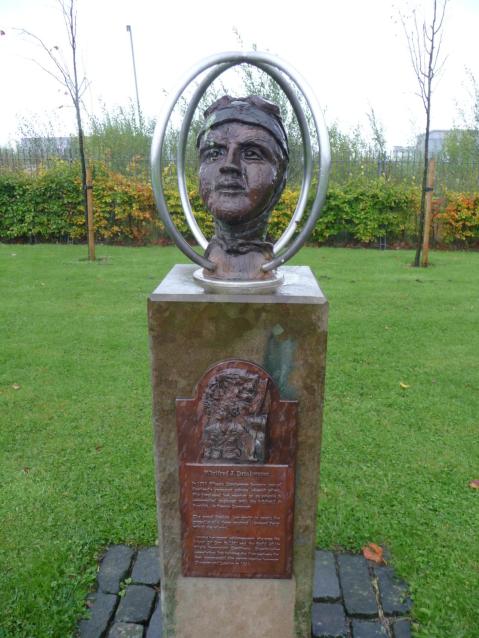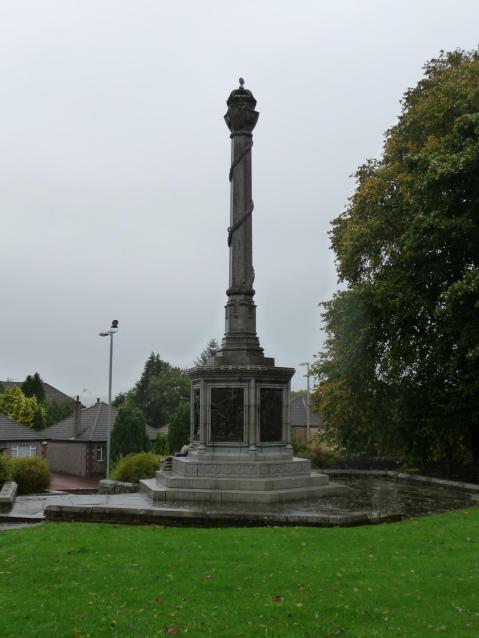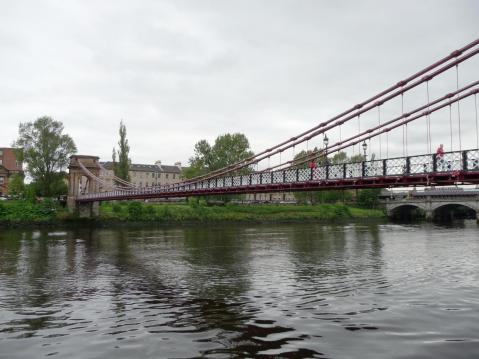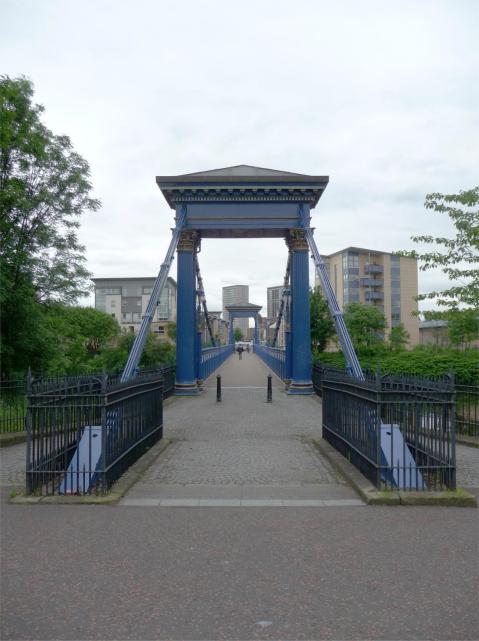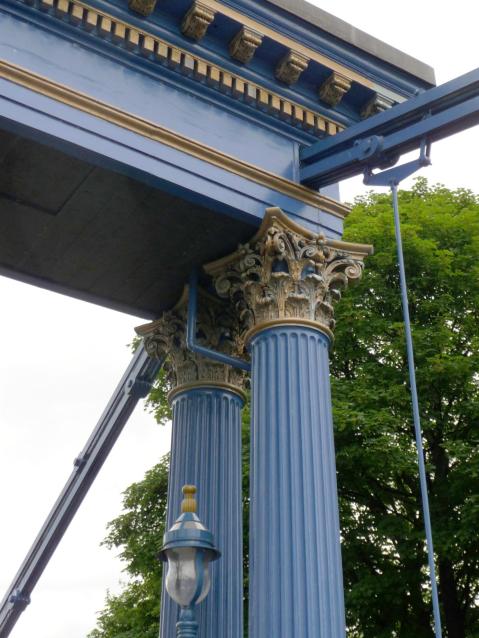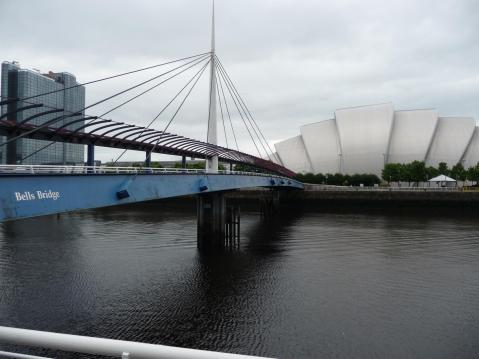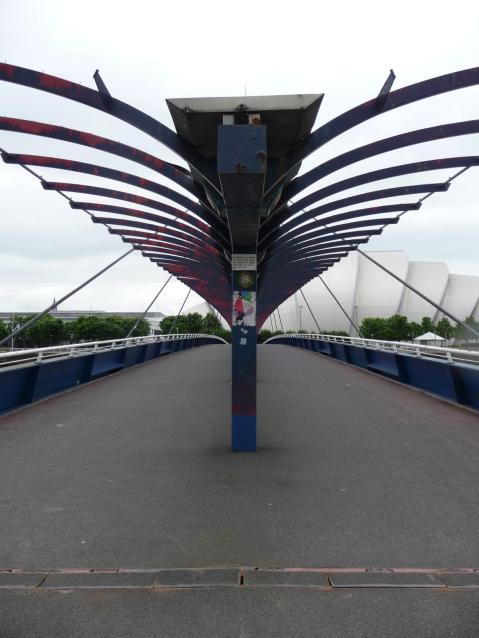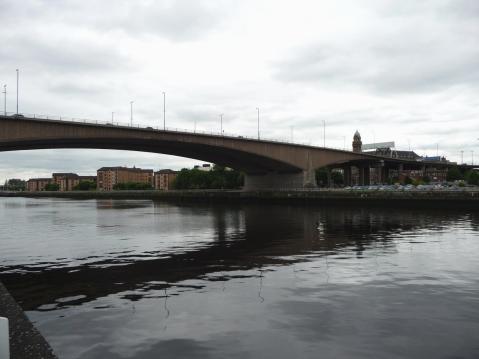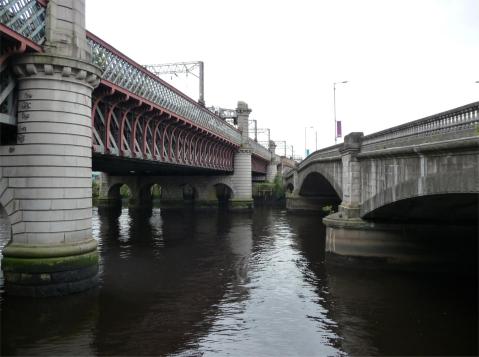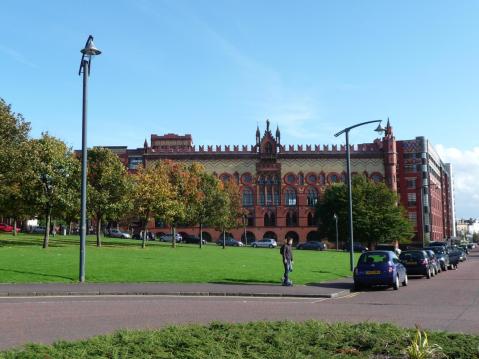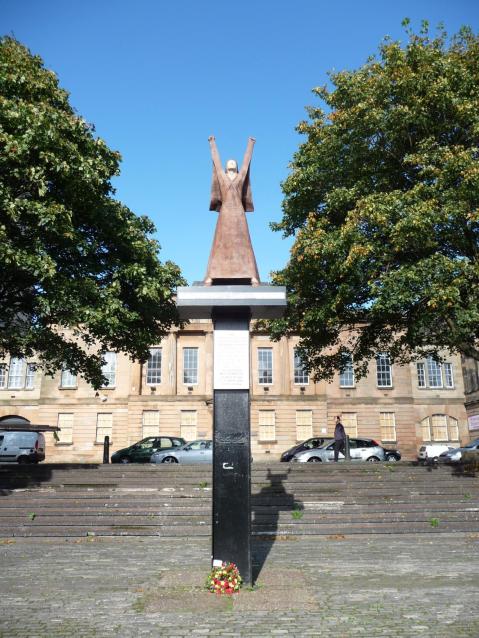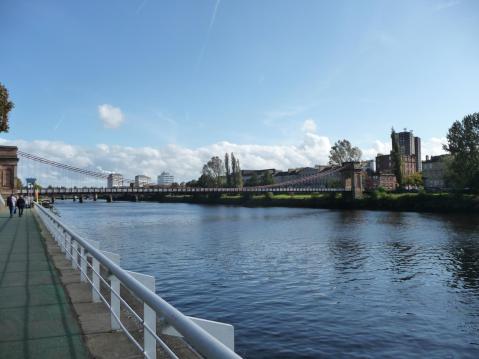A cycle in the rain
Well it’s quite a while since my last post on here. I’m afraid to say I have been guilty of not following the advice of this blog’s title, but last weekend I rectified this, at least a little bit anyway. Despite the rain I went out for a cycle and looked at some of the sights that are close to where I stay.
Only a mile or so from where I live is the Erskine Bridge. This was opened by HRH Princess Anne in 1971. It is 38m (125 feet) high and the total length is 1310m (4300 feet). Back in 1996 a newly constructed oil platform that was being towed down river collided with the deck of the bridge, causing damage which cost almost £4m to repair.
Just a couple of miles from the Erskine Bridge is the beautifully renovated India of Inchinnan building which is Category A listed.
The land this sits on was originally used by William Beardmore & Company for the construction of airships from 1916 until the factory closed in 1922. In 1927 the site and some of the buildings were bought by India Tyres. The art deco style office block was opened in 1931 and lasted until 1981 when the company closed and left the area. Sadly the vacant building was left a tattered shell for many years after it was vandalised and set on fire. The building was built many years later by a local engineering firm and the transformation was completed in 2003. The roof extension to the rear of the building is a scale replica of a section of an R34 airship, paying respect to the site’s heritage.
Travelling along the A8 road to Renfrew. The town is known as the Cradle of the Royal Stewarts due to it’s links to the Royal House and it also has the designation of Royal Burgh. The current Baron of Renfrew is HRH Prince Charles. Entering from the west you have to cross over the bascule bridge. This is a drawbridge style bridge and was completed around 1923. Although the bridge has been renovated and is fully operational it very seldom opens.
In Renfrew there is an area called Braehead which in recent years has seen much development, both commercial and residential. Between the two areas is Clyde View Park. As well as being a greenspace with play/picnic areas, fountains and the riverside walkway, there are a number of sculptures showing the history and importance of the area.
This sculpture represents the importance of the Stewart monarchy and their links to the area.
St Conval was a major founder of monasticism in the British Isles and 300 years after his death, monks based at Inchinnan founded many churches which bore his name. The Lord of the Isles, Somerled, landed at Renfrew in 1164 to try to control the seaways but was attacked and killed by a group of locals, thus ending the Norse influence on the River Clyde.
This sculpture is a reference to the industrial progress made in the area. Developments in engine technology greatly influenced the progress of paddle steamers, then propeller driven ships and even onto aeroplanes. The local Beardsmore’s factory made bi-planes, including the Sopwith Pup during the First World War.
Simons and Lobnitz were two companies who were worldwide leaders in dredging technology in the 19th Century. Dredging the river to maintain the navigational channels was of utmost important to the shipbuilding industries on the Clyde.
The R34 was a hydrogen airship built by the Beardsmore company of Inchinnan in 1919 which was acclaimed for crossing the Atlantic twice. The India Rubber Co. made tyres on the same site as Beardsmore’s for over 50 years playing an important role during World War 2.
Babcock began as boiler makers and opened their factory in Renfrew in 1895. Babcock and Wilcox designed and built engineering equipment from nuclear power staions to marine salvage equipment.
The 602 (City of Glasgow) Squadron of the Royal Auxiliary Air Force were based at the Moorpark Aerodrome in Renfrew. Started as a light bomber unit they became a fighter squadron flying Spitfires and were temporarily re-located in England during the Battle of Britain. The squadron was disbanded in 1957 and later reformed in 2006 to provide operational support.
In 1930 Winifred (Winnie) J. Drinkwater qualified as one of Scotland’s youngest private aircraft pilots. In 1934 she flew what is considered the first day return service between Glasgow and London.
Connecting to Renfrew is the town of Paisley. During the 19th Century Paisley was a major player in the weaving industry, working with cotton and wool and producing shawls and other fabrics in the famous Paisley Pattern.One of the most iconic buildings in the town is the Anchor Thread Mill. By the late 19th Century the J & J Clark Company employed over 3500 people producing 15 tons a day. As you can see in the picture after the heavy rain we had the White Cart Water can get a bit lively.
Just across from the Anchor Mill sits Paisley Abbey. The original priory on the site was upgraded to Abbey status in 1219 due to the rapid growth of the local community. King Robert II was born in the Abbey after his mother, who was horse riding nearby, fell from her horse. All six High Stewards of Scotland are buried in the Abbey.
Finally, moving out of Paisley, you will come to Elderslie, where it is said our very own Braveheart, Mel Gibson, sorry, William Wallace was born. In the village you’ll find the Wallace Memorial, not to be confused with the Wallace Monument in Stirling. Built in 1912 the column is carved from a single piece of stone. Around the base are panels depicting important events from Wallace’s life.
Glasgow Bridges (Part 2 of 2)
The original Glasgow Bridge (or Jamaica Bridge) was completed in 1772. It was replaced in 1833 with a design by Thomas Telford, the 1st President of the Institute of Civil Engineers. It was also the 1st bridge in Glasgow to be lit by electricity. The bridge was widened and the arches enlarged at the end of the 19th Century.
Begun in 1851, the original stone tower on the South side of the South Portland Street Suspension Bridge split vertically resulting in considerable rebuilding. The arch towers are still standing today unlike the suspended decking, hangers, chains etc, which have been replaced a number of times, most recently 1926 and 2004.
Victoria Bridge was completed in 1854 and replaced the 500 year old Bishop’s Bridge due to it being too restrictive for Glasgow’s growing population. It is built on the site of the 1st recorded bridge over the River Clyde (1285) and is Glasgow’s oldest surviving complete bridge.
Built to increase capacity into the north of the city, the City Union Railway Bridge (1899) carried 4 extra tracks into the St Enoch station. It has red sandstone towers and was the 1st permanent Clyde Bridge to be built using a steel superstructure. At the time of construction it was built underneath the existing bridge to allow rail traffic to continue using the lines. The St Enoch Station was closed during the 1966 Beeching Cuts and now the line is only used for freight, charters and transportation for rail maintenance.
The current Albert Bridge is the 5th bridge on this site. It was opened to traffic in 1871. Traditional masonry construction was dismissed in favour of wrought iron arches, the largest spanning 114 feet. It is decorated with various coats of arms including Prince Albert, other Royalty and various corporate bodies. Sadly, nowadays it doesn’t befit it’s Royal connections and is in need of refurbishment.
The Tidal Weir built in 1901, suffered a failure of the foundations and collapsed in 1941. The current steel pipe bridge was completed in 1949 and carries large diameter service pipes across the river.
The main purpose of the weir is to prevent erosion to the banks of the river upstream, otherwise silt washed downstream would need to be regularly dredged. The weir marks the boundary of fresh and salt water and creates 2 different eco-systems supporting a wide range of wildlife. The upstream side is also home to the Glasgow Rowing Club.
The final bridge I shall look at is the St Andrew’s Suspension Bridge. This largely iron bridge was completed in 1856 and was built as a safer replacement for the ferry service used by many factory workers in the area.
Various aspects of the bridge have been replaced over the years and the 20ft (6m) high Corinthian columns and other ornamental features were refurbished in 1997. It is a good viewing point to watch the rowers from the clubs based at Glasgow Green.
Glasgow Bridges (Part 1 of 2)
The River Clyde has been a dominant part in the life of Glasgow and it’s bridges have played an ever more important role in the fortunes of the city. From the earliest recorded bridge in 1285 to the most recent in 2009 these crossings have been pivotal in both social and economic capacities.
Travelling from West to East the 1st bridge we see is the Millennium Bridge.
Built in 2002 as part of the Glasgow Science Centre project to improve links between both sides of the river.
The centre 2 elements of the bridge can be raised to allow the passage of larger vessels. This apparently only requires the same amount of energy as is needed to power a 100 watt lamp. In the background is the Glasgow Science Centre and the Glasgow Tower. The Tower is capable of rotating 360 degrees with the wind but has been beset by many serious problems since it opened. It is currently closed (June 13th 2012).
Next is the Bell’s Bridge. Construction of the bridge, sponsored by Bell’s & Son whisky company, was completed in 1988 with the aim of connecting the site of the International Garden Festival and the S.E.C.C.
The bridge is in 2 sections. The North side is fixed and the South side, the part with the pointed column and support cables rotates 90 degrees to create 2 lanes allowing for large vessels to pass.
One of the most recent bridges on the Clyde is the Clyde Arc. This is fondly known locally as the “Squinty Bridge” due to the fact that it is curved and is built at an angle across the river, which is caused by the location of suitable landing points on the banks.
Probably the most dominant bridge in Glasgow is the Kingston Bridge. It’s also probably the most important given that it carries approximately 150,000 vehicles every day along the M8 motorway through the centre of Glasgow. It is the largest urban bridge in the UK. It was completed in 1970 after 3 years of construction. Due to the heavy use it was strengthened in recent years. The whole bridge was jacked up and moved a distance of 50mm (2 inches). It doesn’t sound much but you must consider that the bridge weighs 52,000 tonnes!!!
The mural on the North support of the bridge, commissioned as part of the Clean Glasgow Campaign, was painted by Australian artist Sam Bates to commemorate the 2014 Glasgow Commonwealth Games. It has been specially treated and is hoped to last for up to 100 years.
The newest bridge in the city is the Tradeston Footbridge in the area of the International Financial Services District. Another bridge with a fun nickname (the Squiggly Bridge) due to it’s curves, it was opened in 2009. The triangular steel ‘fins’ are actually the main support structure which enables the bridge deck to be thinner.
Originally planned for construction in 1914, the George the Fifth Bridge (George V Bridge) was delayed by the onset of World War 1 and was eventually completed in 1928.
Right next to the George V Bridge is the main railway crossing into Glasgow Central Station. This is the 2nd Caledonian Railway Bridge. Due to competition from rival rail companies and the need for development the Caledonian Railway Company built their second bridge across the Clyde in 1905 and was built next to the original bridge.
The Caledonian Railway line originally stopped just south of the river. Then, to compete with the Clyde Union Railway Company who had already crossed the river upstream they built the 1st Caledonian Railway Bridge. The bridge was completed in 1878 and carried 4 tracks across the river. Sadly, the granite piers are all that is left of the original bridge, the rest having been dismantled in the late 1960’s.

The remaining granite piers of the 1st Caledonian Railway Bridge next to the current 2nd Caledonian Railway Bridge
On the granite piers there is an inscription carved by the poet Ian Hamilton Finlay and his collaborators, in Greek and English, a translated quote from Plato’s The Republic which, in English, reads “All greatness stands firm in the storm”.
Around Glasgow Green
Glasgow Green is a park in Glasgow’s East End on the north side of the River Clyde. It is the oldest park in Glasgow dating back to the mid 15th century. Starting out as an area for grazing, cleaning and drying fishing nets it is now very much a recreational park and is home to the People’s Palace museum and Winter Gardens.
The People’s Palace, opened in 1898 was intended to bring culture to the people of Glasgow. It originally included reading and recreation rooms, a museum and an art gallery over it’s 3 floors. It is now a museum depicting the changing social aspects of the City over the years. Adjoining the People’s Palace are the Winter Gardens, an impressive glass structure you must agree, where you can sit amongst the tropical plants and enjoy a drink and a bite to eat.
At the front of the People’s Palace is the, now refurbished and relocated, Doulton Fountain. This was gifted to the City by Sir Henry Doulton (of Royal Doulton fame) and was part of the Empire Exhibition of 1888 in Kelvingrove Park before being moved to Glasgow Green 2 years later. It is the largest terracotta fountain in the world and after it’s £4million refurbishment is one of the best quality too. It has 5 tiers, is 46 feet in height and 70 feet across.
The Templeton Carpet Factory was completed in 1892, but only after tragedy struck. In 1889, during construction of the newer part of the building a wall collapsed trapping 100 female weavers. Sadly 29 were killed. John Templeton of Paisley had patented a method of producing luxurious axminster carpetting which was used in many grand houses and even on the Titanic. The enamel tiles, glazed bricks and terracotta were designed to imitate the patterns of the carpets which the company produced. It also pleased the affluent neighbours who didn’t like the idea of living near a factory. Nowadays it has mixed usage from business to residential.
Finally we have the Nelson Monument. This was the 1st large monument erected in Britain in Nelson’s honour, just a year after his death in the Battle of Trafalgar (1805). Panels around the base of the monument record his naval victories in Aboukir, Copenhagen and Trafalgar. Damage can still be seen from a lightning strike in 1810 in which it lost about 6metres (20 feet). It is 43.5 metres (144 feet) high.
Glasgow sights along the Clyde
I am sure I am like many people in the world and go through my daily routine without a second thought. Blindly following a set pattern of events on auto-pilot so to speak. If I’m driving in my car my eyes are on the road and other traffic. If I’m on a train I’m often reading or talking to others. However, when I’m out cycling there are not so many distractions. I can get lost in my thoughts at a more sedate pace. It’s being out on my bike and travelling at that slower pace that I tend to notice more. Apart from trees and fields and wildlife, there are sculptures, buildings, people and all sorts. That’s why I decided to take a few more leisurely bike rides and take photographs of the sights we can take for granted.
As I am living in the west of Scotland, I thought I’d start with Glasgow. After living in the local area all my life I was surprised how little I actually took notice of. Of course I have seen these objects etc. before but I’ve never really SEEN them. Or found out anything about them. Shame on me.
One very noticeable thing you can see, especially when arriving at Glasgow Central train station is the flaming tiger mural. It was commissioned by Tiger Beer company to celebrate the Year of the Dragon in 2010.
Slightly further along from the Tiger mural is this statue:
This statue, located at Custom House Quay off Clyde Street, is of Basque politician Dolores Ibárruri, otherwise know as “La Pasionaria” or The Passion Flower, who was a leader of the Spanish Republican and Communist movements. It was erected by The City of Glasgow and the Labour Movement as a tribute to the British Volunteers of the International Brigade who fought in the Spanish Civil War of 1936-39, a number of whom came from Glasgow. It was unveiled in 1977. The quote on the plinth reads: “Better to die on your feet than live forever on your knees.”
In the same area is the South Portland Street Suspension Bridge, one of the numerous bridges, old and new, across the Clyde in the City.
Construction started in 1851 and, despite some serious setbacks was completed in 1853. The bridge has been subject to some major refurbishment over the years in 1870 and most recently 1926 when the hangers and decking were replaced and altered, but the masonry arches are as they were in 1853 making them the oldest parts of any of the Clyde bridges.












